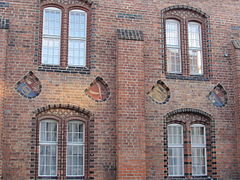Old Town Hall (Brandenburg an der Havel)
The old town hall in the city of Brandenburg an der Havel is as town hall an outstanding architectural monument and example of late medieval brick Gothic .
history

A first town hall building in the old town was already on the old town market from around 1290 . This previous building consisted of a brick cellar and hall made of wood . Around 1450, a two-story extension with vaults and conspicuous circular and coat of arms panels , the council and office rooms, was added to this building.
The old wooden structure was replaced around 1468. The builder of the red brick building is unknown. However, we know that he was also active in the cities of Ziesar and Tangermünde . The two-story replacement building originally had a three-aisled department store on the lower floor . The council chamber was on the upper floor. Other facilities in the building were the city prison , the court arbor , archive and armory . The town hall tower had a clock and carillon early on.
When in 1715 the previously (partially) independent cities of Altstadt and Neustadt were combined to form the city of Brandenburg an der Havel, it was decided to use the Neustadt town hall as the seat. For the old town hall this initially meant vacancy and decay. In 1753 the building was converted for use by a barchent manufactory . As such, it was used until 1803. The town hall was also used as a warehouse, department store and grain store until 1819. Then the regional and city court moved into the house.
It was used as a courthouse until 1863. The next user was the Prussian army. The local garrison had clothes closets and holding cells . The building fell into disrepair and finally had to be evacuated and closed in 1904 because of dilapidation. In order to prevent the threat of demolition, the city bought the old town hall back in 1910 and extensively renovated and restored it in the following two years. It became a representative festival house.
After the New Town Hall was destroyed in the Second World War , the Roland statue was moved in front of the Old Town Hall in 1946 . As a result, the old council chamber was used for meetings of the city council , but the actual city administration was located in other buildings in the city. From 2006 to 2007 another extensive renovation and restoration took place, as a result of which the town hall together with the Ordonnanzhaus became the central seat of the city administration again after three centuries. Since then, for example, the mayor Dietlind Tiemann has her seat in the house.
Roland
The Roland figure goes back to the medieval folk hero Hruotland , known from the Roland song , who fell as a loyal vassal of Charlemagne in a battle of retreat in 778. In medieval cities, the figure was a symbol of legal autonomy or independence of the church and the nobility, for the freedom of the bourgeoisie .
A Roland figure has been handed down in the new town of Brandenburg since 1402. The Roland standing in front of the old town hall was made of sandstone in 1474 . He has a height of 5.33 meters, has plate armor and a sword in his right hand, which is held vertically in the air. The left hand is on the dagger. A copy is in front of the Märkisches Museum Berlin .
Thunderbolt was planted in a small hollow on the head , which, according to a superstition, should protect the figure from lightning strikes .
This Roland was originally on the Neustadt market . However, since this market square was used as a parade ground and the figure hindered the soldiers in their exercises, King Friedrich Wilhelm I gave permission in 1716 to move the Roland right in front of the New Town Hall. In 1941 the Roland was dismantled and stored for protection due to the war. The town hall in the Neustadt was completely destroyed after being hit by a bomb and then removed, whereupon the Brandenburg Roland was placed in front of the old town hall.
Council Chamber
In addition to council meetings, the medieval council hall was used for homage to the sovereigns, receptions and celebrations for patricians . Based on the findings made during the extensive renovation work in the early 21st century, it is assumed that there were stalls at the front of the hall and a seat of honor on the long side. In relation to the conditions in the 21st century, the floor was about 0.8 meters higher.
The large ballroom in its shape is the result of extensive renovations in the second decade of the 20th century. Up to this time the room had a flat roof, but was then raised into the roof space by a wooden barrel vault . A wooden coffered ceiling with painting was attached to this barrel vault . This was covered by a false ceiling in 1962 and as part of renovations in the 21st century. exposed again. Murals were removed after 1918. Windows with leaded glazing show medieval coats of arms of Brandenburg cities. The parquet floor was reconstructed in 2006 based on what was left of it.
gallery
literature
- Kolb: Exposed architecture at the old town hall in Brandenburg ad H. In: The preservation of monuments , 5th year, No. 16 (December 16, 1903), pp. 125–129.
Web links
Individual evidence
- ↑ a b City Hall with Roland . Accessed March 13, 2015.
- ↑ a b Information board for the Old Town Hall and Roland
- ^ Roland statues in Germany. Brandenburg. In: p-schoenfeld.de. Retrieved April 17, 2020 .
- ↑ Information board council chamber .
Coordinates: 52 ° 24 ′ 50.8 ″ N , 12 ° 33 ′ 14 ″ E







